Organisational Governance and Performance Management in Australia
VerifiedAdded on 2020/05/08
|6
|1376
|47
Report
AI Summary
This report provides a comprehensive literature review on safety and quality practices in Australian healthcare, focusing on pricing and funding arrangements undertaken by the IHPA and commission. It discusses four funding models used by public hospitals in Australia: Best practice pricing, Normative pricing, Quality structure pricing models, and Payment for performance or safety and quality pricing. The report critically analyzes the National Efficient Price (NEP) system, evaluating its potential to incentivize improvements in health status across different segments of the Australian population. It highlights the limitations of NEP, including potential misallocation of resources and the challenges of stimulating major changes in hospital safety and quality. The report references key literature and concludes that NEP may not significantly improve the health status of the population. The report also discusses the potential for regional disparities and the flaws in the activity-based funding scheme. It suggests that NEP can secure efficiency gains by stimulating the change behaviour of the health professionals.
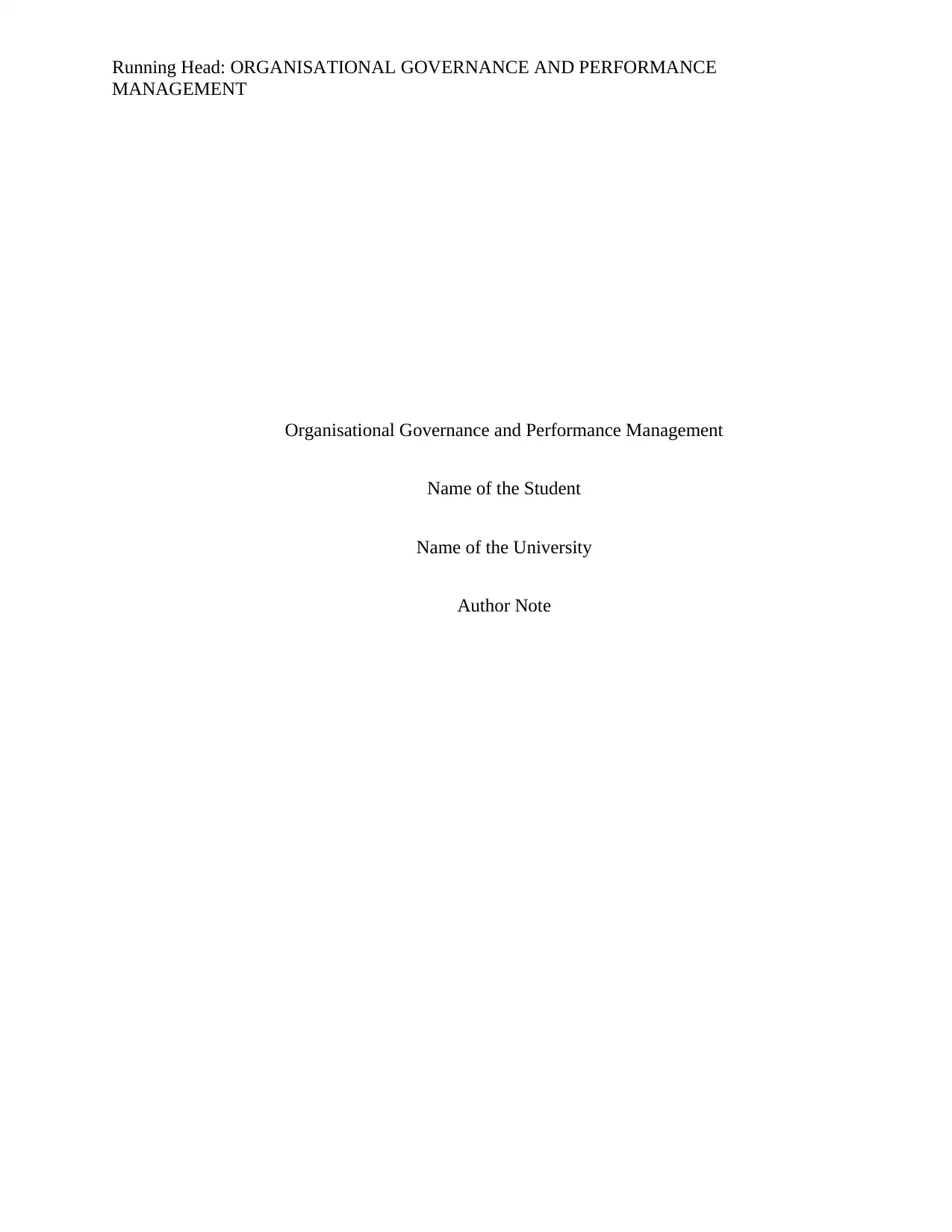
Running Head: ORGANISATIONAL GOVERNANCE AND PERFORMANCE
MANAGEMENT
Organisational Governance and Performance Management
Name of the Student
Name of the University
Author Note
MANAGEMENT
Organisational Governance and Performance Management
Name of the Student
Name of the University
Author Note
Paraphrase This Document
Need a fresh take? Get an instant paraphrase of this document with our AI Paraphraser
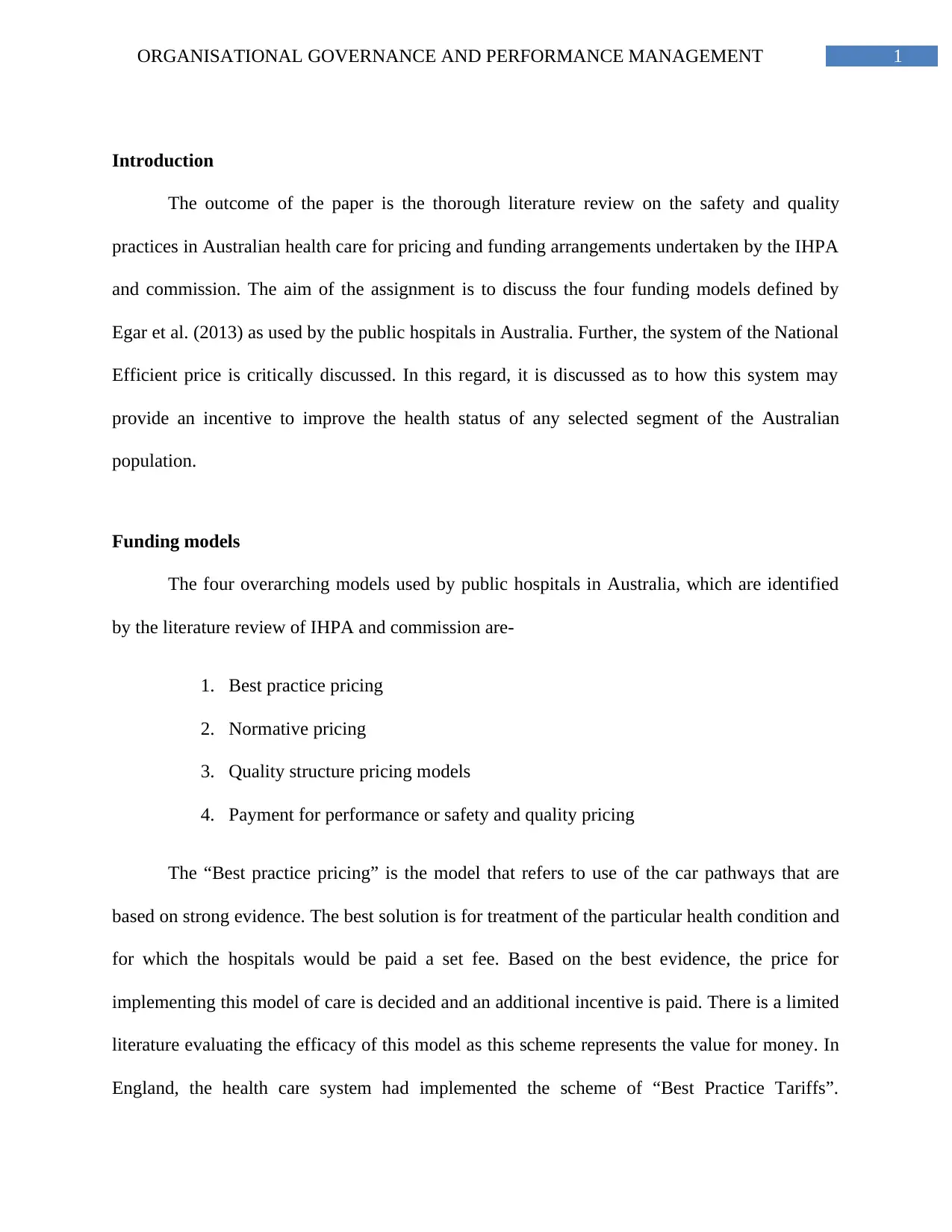
1ORGANISATIONAL GOVERNANCE AND PERFORMANCE MANAGEMENT
Introduction
The outcome of the paper is the thorough literature review on the safety and quality
practices in Australian health care for pricing and funding arrangements undertaken by the IHPA
and commission. The aim of the assignment is to discuss the four funding models defined by
Egar et al. (2013) as used by the public hospitals in Australia. Further, the system of the National
Efficient price is critically discussed. In this regard, it is discussed as to how this system may
provide an incentive to improve the health status of any selected segment of the Australian
population.
Funding models
The four overarching models used by public hospitals in Australia, which are identified
by the literature review of IHPA and commission are-
1. Best practice pricing
2. Normative pricing
3. Quality structure pricing models
4. Payment for performance or safety and quality pricing
The “Best practice pricing” is the model that refers to use of the car pathways that are
based on strong evidence. The best solution is for treatment of the particular health condition and
for which the hospitals would be paid a set fee. Based on the best evidence, the price for
implementing this model of care is decided and an additional incentive is paid. There is a limited
literature evaluating the efficacy of this model as this scheme represents the value for money. In
England, the health care system had implemented the scheme of “Best Practice Tariffs”.
Introduction
The outcome of the paper is the thorough literature review on the safety and quality
practices in Australian health care for pricing and funding arrangements undertaken by the IHPA
and commission. The aim of the assignment is to discuss the four funding models defined by
Egar et al. (2013) as used by the public hospitals in Australia. Further, the system of the National
Efficient price is critically discussed. In this regard, it is discussed as to how this system may
provide an incentive to improve the health status of any selected segment of the Australian
population.
Funding models
The four overarching models used by public hospitals in Australia, which are identified
by the literature review of IHPA and commission are-
1. Best practice pricing
2. Normative pricing
3. Quality structure pricing models
4. Payment for performance or safety and quality pricing
The “Best practice pricing” is the model that refers to use of the car pathways that are
based on strong evidence. The best solution is for treatment of the particular health condition and
for which the hospitals would be paid a set fee. Based on the best evidence, the price for
implementing this model of care is decided and an additional incentive is paid. There is a limited
literature evaluating the efficacy of this model as this scheme represents the value for money. In
England, the health care system had implemented the scheme of “Best Practice Tariffs”.
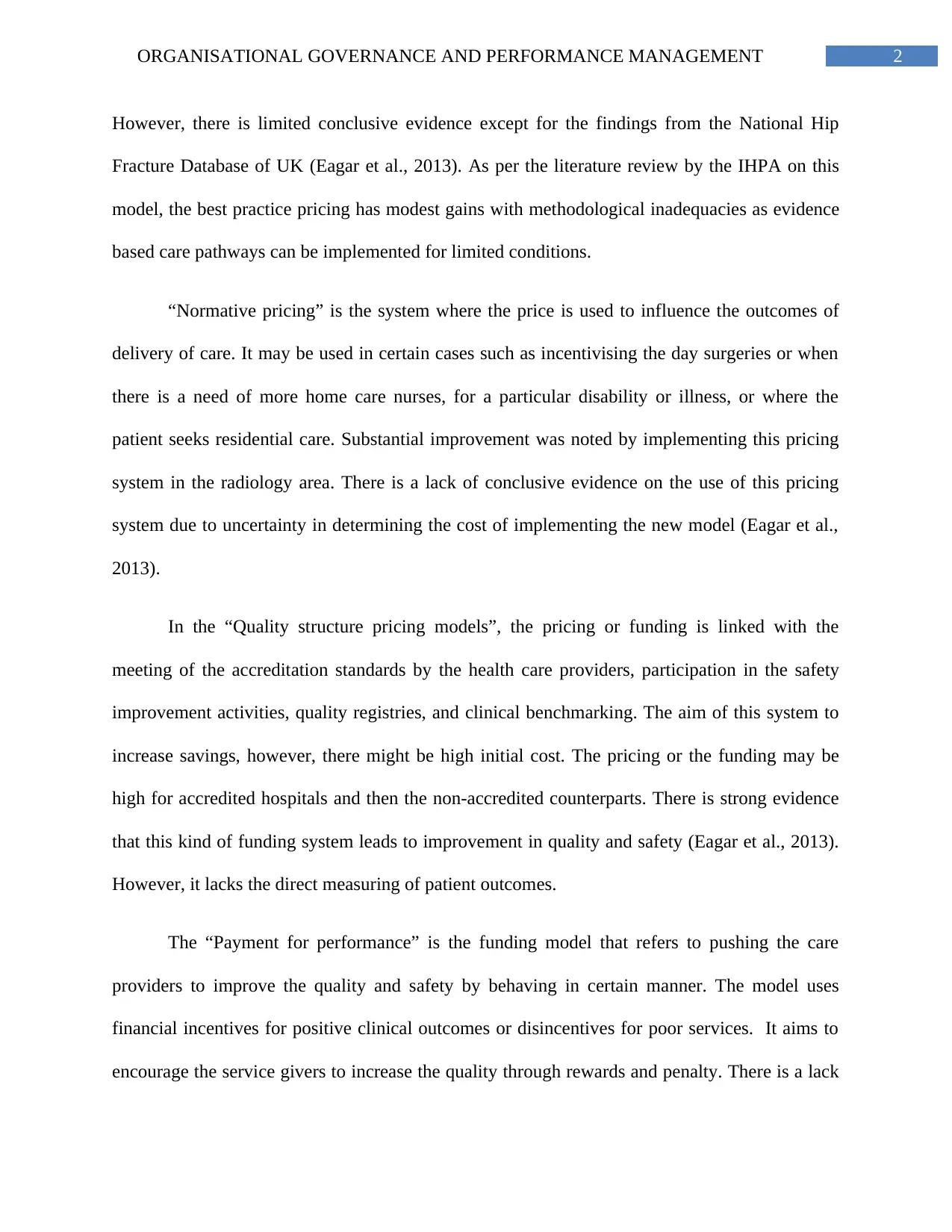
2ORGANISATIONAL GOVERNANCE AND PERFORMANCE MANAGEMENT
However, there is limited conclusive evidence except for the findings from the National Hip
Fracture Database of UK (Eagar et al., 2013). As per the literature review by the IHPA on this
model, the best practice pricing has modest gains with methodological inadequacies as evidence
based care pathways can be implemented for limited conditions.
“Normative pricing” is the system where the price is used to influence the outcomes of
delivery of care. It may be used in certain cases such as incentivising the day surgeries or when
there is a need of more home care nurses, for a particular disability or illness, or where the
patient seeks residential care. Substantial improvement was noted by implementing this pricing
system in the radiology area. There is a lack of conclusive evidence on the use of this pricing
system due to uncertainty in determining the cost of implementing the new model (Eagar et al.,
2013).
In the “Quality structure pricing models”, the pricing or funding is linked with the
meeting of the accreditation standards by the health care providers, participation in the safety
improvement activities, quality registries, and clinical benchmarking. The aim of this system to
increase savings, however, there might be high initial cost. The pricing or the funding may be
high for accredited hospitals and then the non-accredited counterparts. There is strong evidence
that this kind of funding system leads to improvement in quality and safety (Eagar et al., 2013).
However, it lacks the direct measuring of patient outcomes.
The “Payment for performance” is the funding model that refers to pushing the care
providers to improve the quality and safety by behaving in certain manner. The model uses
financial incentives for positive clinical outcomes or disincentives for poor services. It aims to
encourage the service givers to increase the quality through rewards and penalty. There is a lack
However, there is limited conclusive evidence except for the findings from the National Hip
Fracture Database of UK (Eagar et al., 2013). As per the literature review by the IHPA on this
model, the best practice pricing has modest gains with methodological inadequacies as evidence
based care pathways can be implemented for limited conditions.
“Normative pricing” is the system where the price is used to influence the outcomes of
delivery of care. It may be used in certain cases such as incentivising the day surgeries or when
there is a need of more home care nurses, for a particular disability or illness, or where the
patient seeks residential care. Substantial improvement was noted by implementing this pricing
system in the radiology area. There is a lack of conclusive evidence on the use of this pricing
system due to uncertainty in determining the cost of implementing the new model (Eagar et al.,
2013).
In the “Quality structure pricing models”, the pricing or funding is linked with the
meeting of the accreditation standards by the health care providers, participation in the safety
improvement activities, quality registries, and clinical benchmarking. The aim of this system to
increase savings, however, there might be high initial cost. The pricing or the funding may be
high for accredited hospitals and then the non-accredited counterparts. There is strong evidence
that this kind of funding system leads to improvement in quality and safety (Eagar et al., 2013).
However, it lacks the direct measuring of patient outcomes.
The “Payment for performance” is the funding model that refers to pushing the care
providers to improve the quality and safety by behaving in certain manner. The model uses
financial incentives for positive clinical outcomes or disincentives for poor services. It aims to
encourage the service givers to increase the quality through rewards and penalty. There is a lack
⊘ This is a preview!⊘
Do you want full access?
Subscribe today to unlock all pages.

Trusted by 1+ million students worldwide
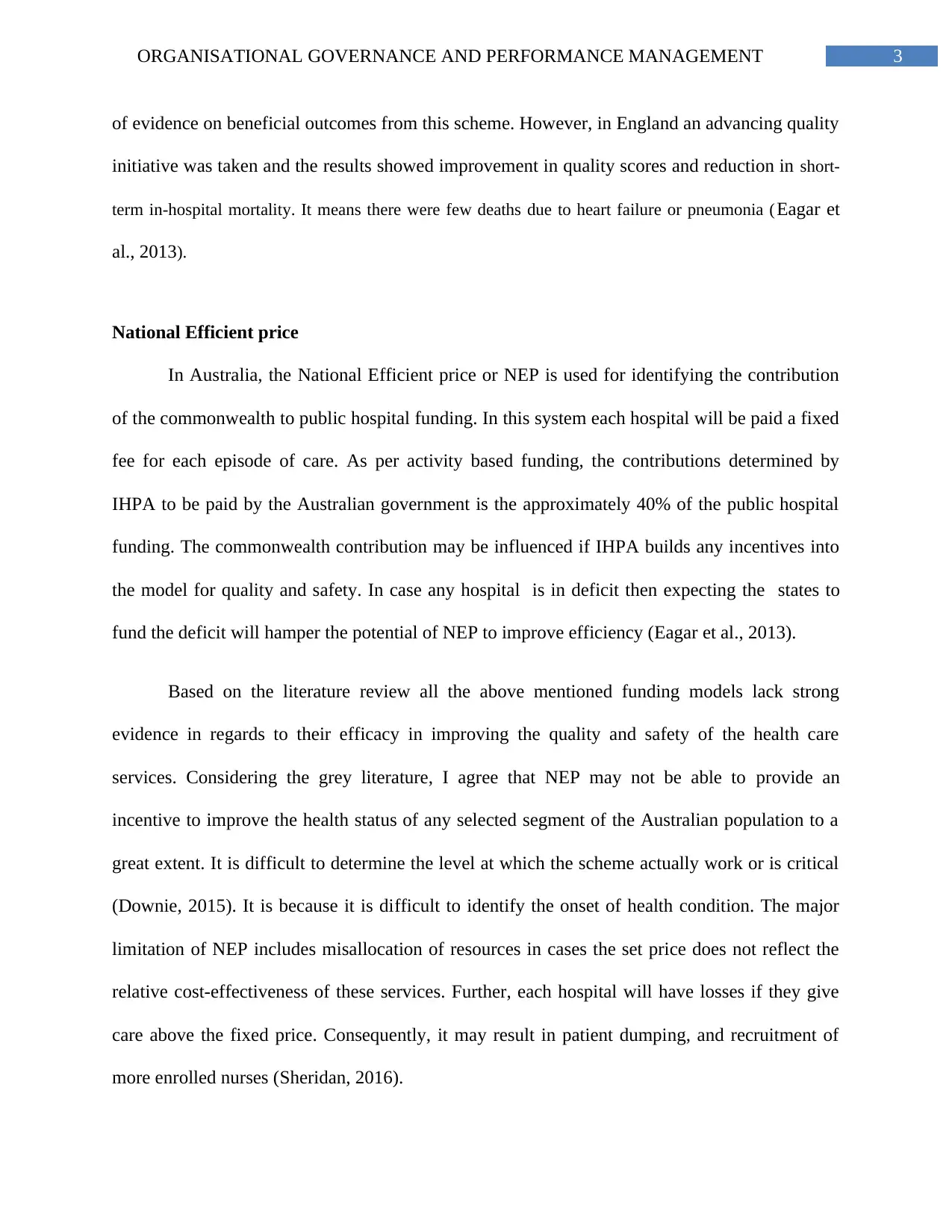
3ORGANISATIONAL GOVERNANCE AND PERFORMANCE MANAGEMENT
of evidence on beneficial outcomes from this scheme. However, in England an advancing quality
initiative was taken and the results showed improvement in quality scores and reduction in short-
term in-hospital mortality. It means there were few deaths due to heart failure or pneumonia (Eagar et
al., 2013).
National Efficient price
In Australia, the National Efficient price or NEP is used for identifying the contribution
of the commonwealth to public hospital funding. In this system each hospital will be paid a fixed
fee for each episode of care. As per activity based funding, the contributions determined by
IHPA to be paid by the Australian government is the approximately 40% of the public hospital
funding. The commonwealth contribution may be influenced if IHPA builds any incentives into
the model for quality and safety. In case any hospital is in deficit then expecting the states to
fund the deficit will hamper the potential of NEP to improve efficiency (Eagar et al., 2013).
Based on the literature review all the above mentioned funding models lack strong
evidence in regards to their efficacy in improving the quality and safety of the health care
services. Considering the grey literature, I agree that NEP may not be able to provide an
incentive to improve the health status of any selected segment of the Australian population to a
great extent. It is difficult to determine the level at which the scheme actually work or is critical
(Downie, 2015). It is because it is difficult to identify the onset of health condition. The major
limitation of NEP includes misallocation of resources in cases the set price does not reflect the
relative cost-effectiveness of these services. Further, each hospital will have losses if they give
care above the fixed price. Consequently, it may result in patient dumping, and recruitment of
more enrolled nurses (Sheridan, 2016).
of evidence on beneficial outcomes from this scheme. However, in England an advancing quality
initiative was taken and the results showed improvement in quality scores and reduction in short-
term in-hospital mortality. It means there were few deaths due to heart failure or pneumonia (Eagar et
al., 2013).
National Efficient price
In Australia, the National Efficient price or NEP is used for identifying the contribution
of the commonwealth to public hospital funding. In this system each hospital will be paid a fixed
fee for each episode of care. As per activity based funding, the contributions determined by
IHPA to be paid by the Australian government is the approximately 40% of the public hospital
funding. The commonwealth contribution may be influenced if IHPA builds any incentives into
the model for quality and safety. In case any hospital is in deficit then expecting the states to
fund the deficit will hamper the potential of NEP to improve efficiency (Eagar et al., 2013).
Based on the literature review all the above mentioned funding models lack strong
evidence in regards to their efficacy in improving the quality and safety of the health care
services. Considering the grey literature, I agree that NEP may not be able to provide an
incentive to improve the health status of any selected segment of the Australian population to a
great extent. It is difficult to determine the level at which the scheme actually work or is critical
(Downie, 2015). It is because it is difficult to identify the onset of health condition. The major
limitation of NEP includes misallocation of resources in cases the set price does not reflect the
relative cost-effectiveness of these services. Further, each hospital will have losses if they give
care above the fixed price. Consequently, it may result in patient dumping, and recruitment of
more enrolled nurses (Sheridan, 2016).
Paraphrase This Document
Need a fresh take? Get an instant paraphrase of this document with our AI Paraphraser
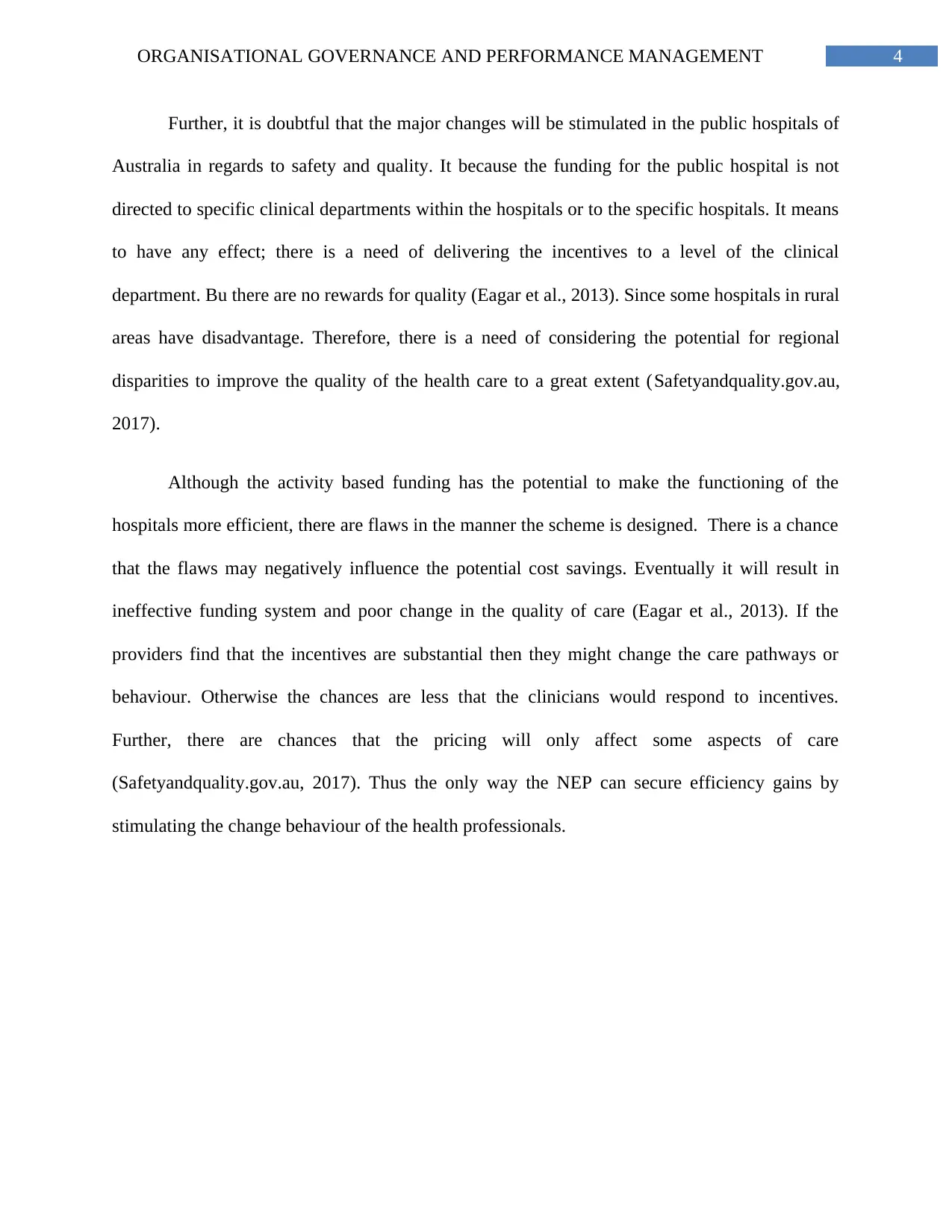
4ORGANISATIONAL GOVERNANCE AND PERFORMANCE MANAGEMENT
Further, it is doubtful that the major changes will be stimulated in the public hospitals of
Australia in regards to safety and quality. It because the funding for the public hospital is not
directed to specific clinical departments within the hospitals or to the specific hospitals. It means
to have any effect; there is a need of delivering the incentives to a level of the clinical
department. Bu there are no rewards for quality (Eagar et al., 2013). Since some hospitals in rural
areas have disadvantage. Therefore, there is a need of considering the potential for regional
disparities to improve the quality of the health care to a great extent (Safetyandquality.gov.au,
2017).
Although the activity based funding has the potential to make the functioning of the
hospitals more efficient, there are flaws in the manner the scheme is designed. There is a chance
that the flaws may negatively influence the potential cost savings. Eventually it will result in
ineffective funding system and poor change in the quality of care (Eagar et al., 2013). If the
providers find that the incentives are substantial then they might change the care pathways or
behaviour. Otherwise the chances are less that the clinicians would respond to incentives.
Further, there are chances that the pricing will only affect some aspects of care
(Safetyandquality.gov.au, 2017). Thus the only way the NEP can secure efficiency gains by
stimulating the change behaviour of the health professionals.
Further, it is doubtful that the major changes will be stimulated in the public hospitals of
Australia in regards to safety and quality. It because the funding for the public hospital is not
directed to specific clinical departments within the hospitals or to the specific hospitals. It means
to have any effect; there is a need of delivering the incentives to a level of the clinical
department. Bu there are no rewards for quality (Eagar et al., 2013). Since some hospitals in rural
areas have disadvantage. Therefore, there is a need of considering the potential for regional
disparities to improve the quality of the health care to a great extent (Safetyandquality.gov.au,
2017).
Although the activity based funding has the potential to make the functioning of the
hospitals more efficient, there are flaws in the manner the scheme is designed. There is a chance
that the flaws may negatively influence the potential cost savings. Eventually it will result in
ineffective funding system and poor change in the quality of care (Eagar et al., 2013). If the
providers find that the incentives are substantial then they might change the care pathways or
behaviour. Otherwise the chances are less that the clinicians would respond to incentives.
Further, there are chances that the pricing will only affect some aspects of care
(Safetyandquality.gov.au, 2017). Thus the only way the NEP can secure efficiency gains by
stimulating the change behaviour of the health professionals.
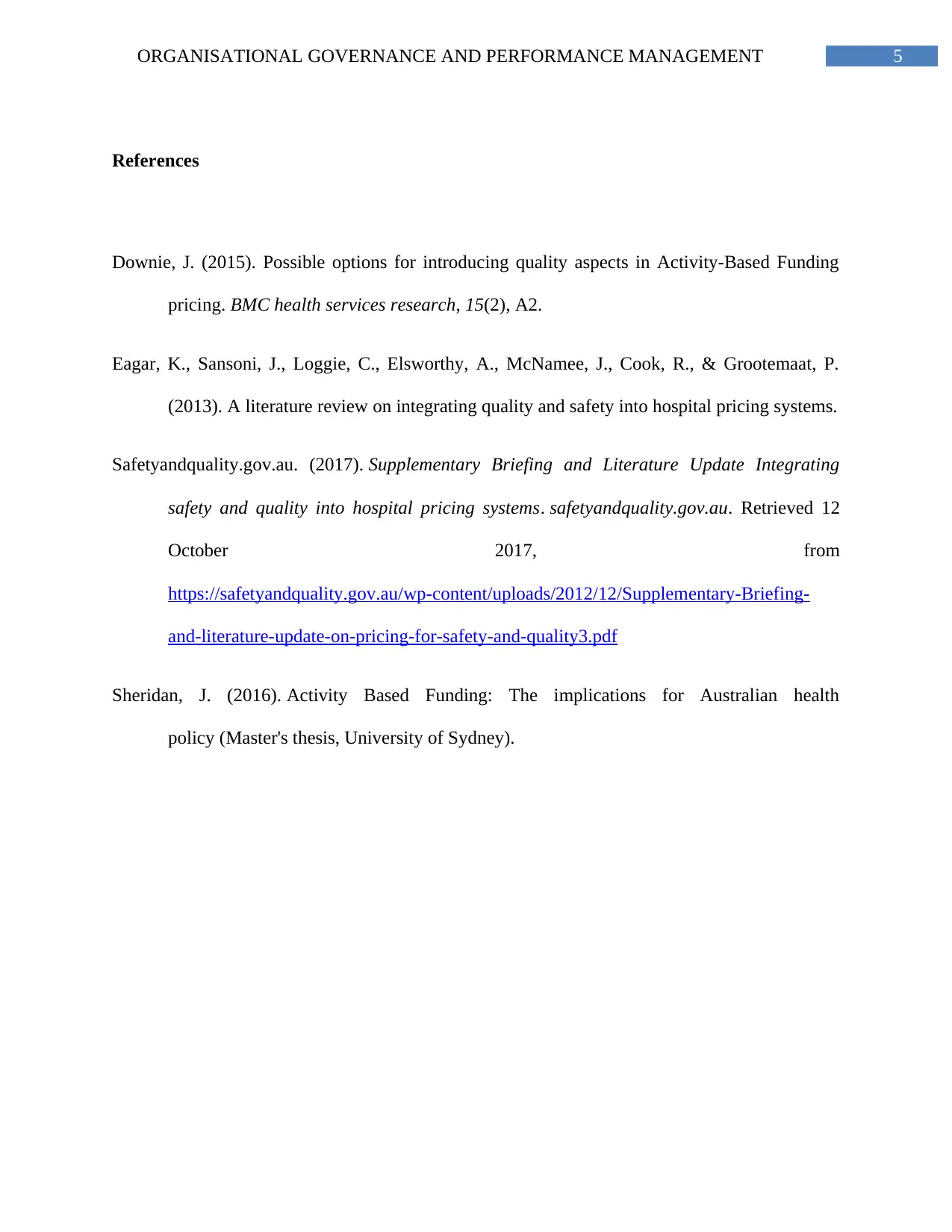
5ORGANISATIONAL GOVERNANCE AND PERFORMANCE MANAGEMENT
References
Downie, J. (2015). Possible options for introducing quality aspects in Activity-Based Funding
pricing. BMC health services research, 15(2), A2.
Eagar, K., Sansoni, J., Loggie, C., Elsworthy, A., McNamee, J., Cook, R., & Grootemaat, P.
(2013). A literature review on integrating quality and safety into hospital pricing systems.
Safetyandquality.gov.au. (2017). Supplementary Briefing and Literature Update Integrating
safety and quality into hospital pricing systems. safetyandquality.gov.au. Retrieved 12
October 2017, from
https://safetyandquality.gov.au/wp-content/uploads/2012/12/Supplementary-Briefing-
and-literature-update-on-pricing-for-safety-and-quality3.pdf
Sheridan, J. (2016). Activity Based Funding: The implications for Australian health
policy (Master's thesis, University of Sydney).
References
Downie, J. (2015). Possible options for introducing quality aspects in Activity-Based Funding
pricing. BMC health services research, 15(2), A2.
Eagar, K., Sansoni, J., Loggie, C., Elsworthy, A., McNamee, J., Cook, R., & Grootemaat, P.
(2013). A literature review on integrating quality and safety into hospital pricing systems.
Safetyandquality.gov.au. (2017). Supplementary Briefing and Literature Update Integrating
safety and quality into hospital pricing systems. safetyandquality.gov.au. Retrieved 12
October 2017, from
https://safetyandquality.gov.au/wp-content/uploads/2012/12/Supplementary-Briefing-
and-literature-update-on-pricing-for-safety-and-quality3.pdf
Sheridan, J. (2016). Activity Based Funding: The implications for Australian health
policy (Master's thesis, University of Sydney).
⊘ This is a preview!⊘
Do you want full access?
Subscribe today to unlock all pages.

Trusted by 1+ million students worldwide
1 out of 6
Related Documents
Your All-in-One AI-Powered Toolkit for Academic Success.
+13062052269
info@desklib.com
Available 24*7 on WhatsApp / Email
![[object Object]](/_next/static/media/star-bottom.7253800d.svg)
Unlock your academic potential
Copyright © 2020–2025 A2Z Services. All Rights Reserved. Developed and managed by ZUCOL.




